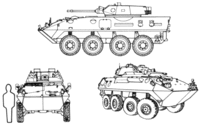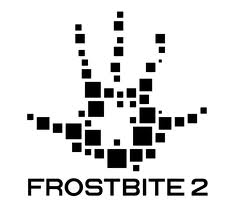Part 8: Episode 9: Stealth Mission
Episode Nine: Stealth MissionYouTube: http://www.youtube.com/watch?v=yvaxOUcv7UA
I completely forget the actual date of bin Laden's death, it happened in May, not October of 2011. It gives us a rough frame of reference for when someone at DICE decided they needed a single player component, through.
The Weapons of Battlefield 3
The LAV-25

Looking like a mix between a tank and the famed Stryker armored transport (the LAV is actually a generation behind the Stryker), the LAV is an amphibious reconnaissance vehicle in service with the Marines since 1983. Manufactured by General Dynamics Land Systems the LAV has seen use in Panama, the Gulf War and the Wars in Iraq and Afghanistan. LAV stands for Light Armored Vehicle and is meant to be less heavily armored and armed than the M1 Abrams and faster, sprinting ahead of other forces to scout the area ahead. LAVs are wheeled vehicles, with eight total. It is technically a rear wheel drive, the back four wheels propel the vehicle forward, but the LAV can switch to 8 wheel drive mode if needed. In either of these modes the LAV is about twice as fast as the Abrams, hitting 62 miles per hour.
In water the vehicle speed is greatly reduced to about 12 MPH due to weight and the relatively small propellers the LAV uses. Though this is a major feature of the vehicle, letting it range through rather than around bodies of water, some of the life extended LAVs have lost this ability due to the various modifications installed. Speaking of, the LAV has had three model numbers, the LAV-25, the LAV-25A1 and the LAV-A2. Within each of these models there are a number of versions fitted for Anti-Tank, Anti-Air and even electronics warfare. Despite the diversity in weapons and purpose the LAV family still carries a high part-interchangeability factor, though later renditions, such as the LAV-A2 make use of electronics over hydraulics in the turret section and different sighting and fire suppression systems. Upgrades to existing LAVs can reduce some of the commonality issues.
The stock and standard LAV is supplied with three weapons, the main weapon being the M242 Bushmaster auto cannon. This weapon in and of itself is interesting as it doesn’t rely on recoil or gas capture to cycle rounds, but uses a DC motor and chain system to fire a 25mm shell. The other two weapons are M240 LMGs, one mounted and attached to the main cannon, the other on the roof of the vehicle to be used like a turret.
Like in real life the LAV-25 in BF3 can carry up to six people, including the driver and a gunner in the second seat. The driver has access by default to the M242, but not the coaxial LMG, but can open up access to that along with TOW missiles, anti tank rounds and guided missiles. The anti tank rounds are interesting, as it has limited drop and no splash damage, a high contrast to the high explosive rounds normally fired by the LAV. These shots can kill a tank in as few as five shots and bypass reactive armor. These rounds make the LAV extremely dangerous to tanks and infantry, but the LAV’s limited turning radius and lower armor score make them very vulnerable to enemy armor and rockets just the same.
LAV’s appear on a number of “infantry only” maps like Seine Crossing and Grand Bazar as well as mixed vehicle maps like Noshahr Canals and Kharg Island, where it sometimes comes into direct conflict with the Russian counterpart : the BMP-2. Seine Crossing is an interesting instance of the vehicle as it appears only for the attacking Marines in the Rush game variant, making it a focal point for the defending Russians and a major asset for the Marines. Games can be won or lost depending on how the LAV is used, and if the Russians are able to steal and maintain the LAV the Marines can win, but will have a difficult time of it with the way the early MCOMM stations are laid out.
The Features of Battlefield 3
The Frostbite Engine

The Frostbite engine (possibly named after a map in Battlefield 2: Modern Combat, the original console only Battlefield game) is what ties all of the last few Battlefield games together. It is the graphics, sound, lighting, physics and destruction systems of the game combined into one package. Frostbite debuted with the first Bad Company game, garnering praise for the ability to destroy the environment, clean graphics (for a game of that size on a console) and sound design. That last point has earned an odd amount of attention from critics and fans and is sometimes singled out as a favorite feature of the BF franchise. Playing BF3 right after a session in a Call of Duty game the difference in sound design is startling. Frostbite uses a form of HDR (high dynamic range) in their sound design. HDR is normally associated with lighting (the “Bloom” effect), but it works incredibly well in Battlefield as Frostbite prioritizes sounds based on overall volume, proximity and in-game priority. This means the footsteps in the next room will get drop in “priority” in the sound engine as other events take place, like jet passing overhead or a nearby teammate spotting an enemy. Even though the footsteps are closer than the jet or teammate, they lose a lot of their volume because the jet is so much louder and the teammate calling out an enemy has priority. This is a pretty important thing as you’ll often hear a tank or helicopter coming long before you see them and prepare accordingly. A nice side effect is that when things get crazy: explosions and gunfire everywhere as jets strafe the area the suppression mechanic supplements the sound design adding another layer of chaos to everything.
The extreme lens flare and brightness is also an effect of Frostbite, and also a HDR effect. That one is a bit more subtle, but it is noticeable when something disturbs a constant light source. In an open, very sunny map like Kharg Island the sun can full out blind players who look towards it, making it difficult to see enemies standing against it. However, if a tank shell explodes nearby the screen goes dark for a second and it takes a moment to recover due to the overwhelming brightness of the explosion. While these are sort of minor effects they add some atmosphere to the game.
The previously mentioned destruction and ballistics engines are tied into Frostbite as well, but are upgraded independently as well, with higher and lower levels of destruction being offered between games running on the same version of Frostbite. Frostbite has been used as the game engine in other EA titles as well, powering the partially-DICE-developed Medal of Honor, Need For Speed: the Run and the upcoming Army of Two reboot. Because Frostbite is already proven on multiple platforms it makes sense for EA to use it instead of licensing out another engine or creating a new one for games.
The Frostbite engine is far from perfect, however. DICE is about as well known for their bugs as they are for the games that contain them. BF3’s version of Frostbite has some major sound bugs, including silencing the game entirely for a player. Control input bugs sometimes make it completely impossible for someone to beyond 60 degrees in any direction (this is rare, it only hit me once and no one else seems to have experienced it) and sometimes wonky physics that send bodies flying despite the fact there are no ragdolls in the game.
Despite this the benefits of Frostbite outweigh the bugs it is packaged with and make the overall Battlefield experience possible as most current game engines can hardly stand small maps, 12 players and limited non-player objects and physics (I’m looking at you, Quake-powered Call of Duty).